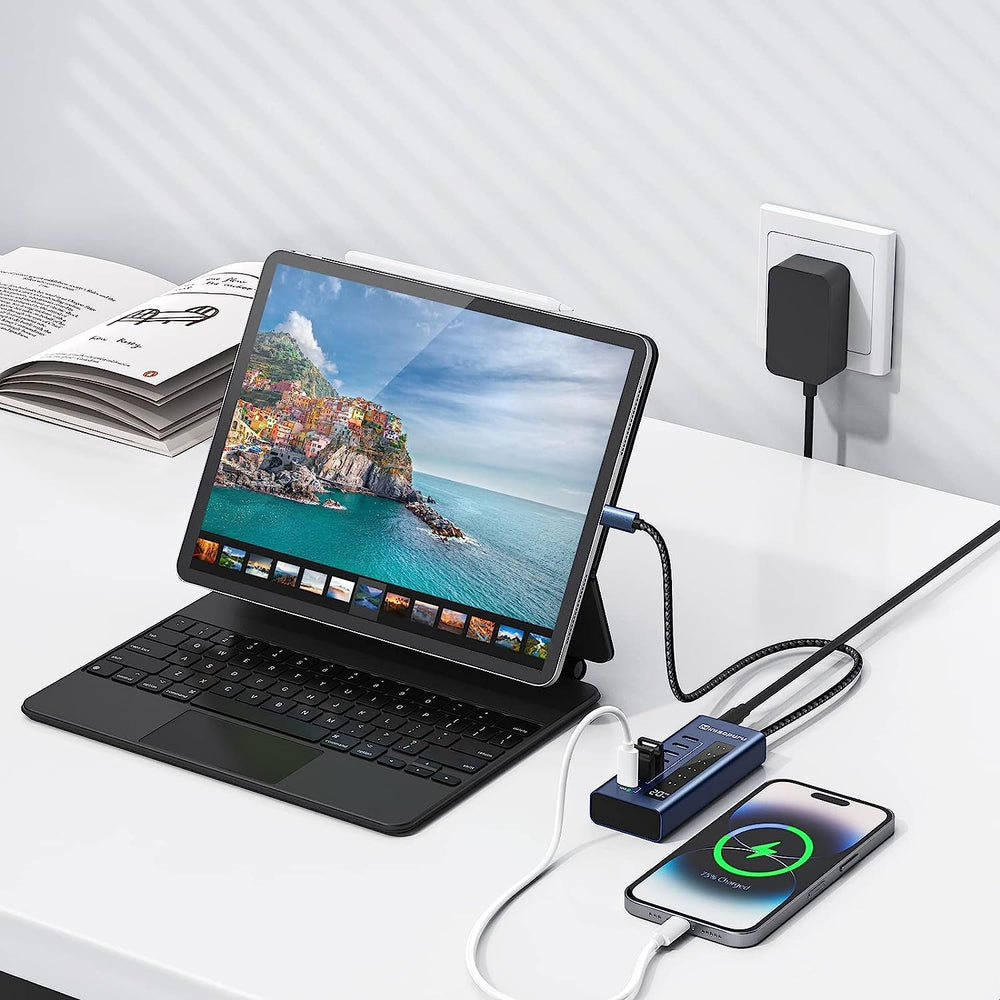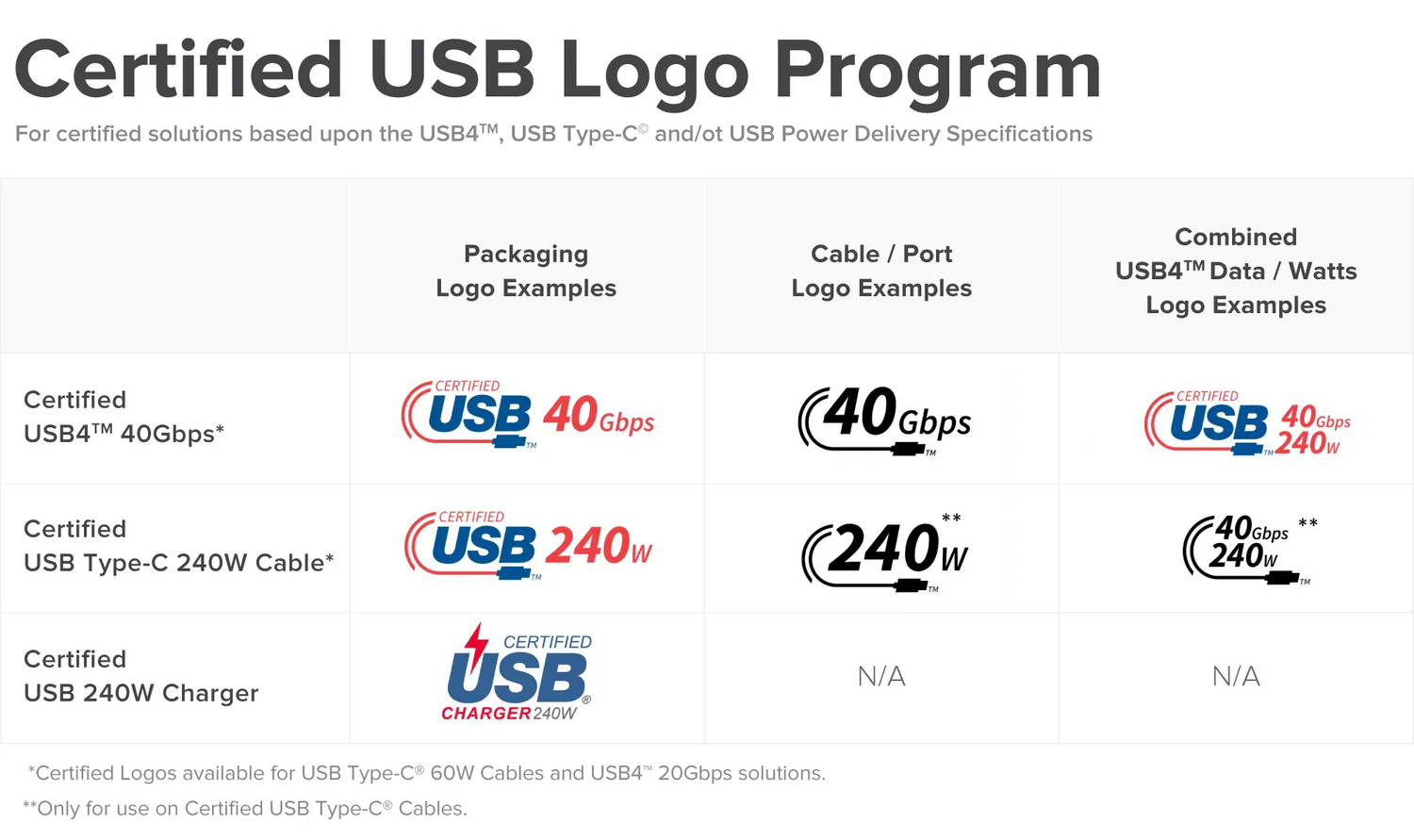USB (Universal Serial Bus) has transformed from a data interface with limited power capacity to a significant power provider. Nowadays, there are numerous devices that can be charged via USB ports found in cars, displays, docking stations, workstations, laptops, and even wall sockets. USB has become a popular power source for many small devices such as portable speakers, tablets, cellphones, and cameras. People worldwide use USB not only to charge or power their devices but also to transfer data.

Please take note of the following important details regarding the above infographic:
It's important to note that you can't use any old USB-C cable or charger to send 240 watts of power. This is because the new specification increases the voltage to 48 volts while keeping the current rating at 5 amps. As you may recall from high school physics, volts times amps equal watts. Therefore, 48 volts x 5 amps = 240 watts.
Prior to this major update, the maximum power delivery of USB PD was limited to only 100 watts with 20V and 5A. The USB Implementers Forum (USB IF) has officially named cables and chargers with 240-watt capability "EPR" (Extended Power Range).
The USB IF has also updated the Type-C specifications to define the requirements for 240-watt cable capabilities. The new Type-C 2.1 cables will be able to handle the latest USB PD 3.1 protocol.

There are numerous devices that require more power than what the older version of the USB PD protocol (100 watts) can provide. While a 100-watt power supply is sufficient for most smartphones, it falls short for power-hungry devices like gaming laptops, displays, docking stations, and mobile workstations.
USB Type-C has the potential to charge and power e-bikes, power garden tools, and laser printers. However, the 100-watt limit is insufficient for these purposes.
Fortunately, with the upgraded USB-C offering 240 watts of power, you can now connect these high-power demanding devices, including 4K monitors and LED TVs. This means you may no longer need to rely on proprietary cables and chargers stored in your junk drawer.
It's worth noting that the USB Implementers Forum requires all new cables and chargers with PD 3.1 capability to display specific icons for the convenience of end-users. This allows customers to visually confirm that they're purchasing cables with 240-watt support.

It's important to note that PD 3.1 is designed to work with the current standard. This means that all products with new specifications will offer backward compatibility. You will be able to run older cables with new 3.1 PD ports on lower power levels and vice versa.
The new specification aims to encourage the industry to adopt ERP-capable products.
All new products with PD 3.1 protocol specifications will be visually identifiable, making it easy for users to purchase 240-watt cables and chargers.
What does the USB PD Protocol entail?
The USB PD (Power Delivery) Protocol is an established industry standard that facilitates efficient charging of devices by managing high power. It offers enhanced flexibility in terms of data transfer and power delivery by enabling the maximum functionality of USB over a single cable.PD 3.1 Protocol

Please take note of the following important details regarding the above infographic:
- The maximum value of the green bar should be 240 watts instead of 100 watts.
- You may also include icons for "e-scooter," "laser printer," and 4K displays above the 240-watt mark.
- Please use "USB PD 3.1 Protocol" instead of simply "USB Power Delivery."
Source
The recently announced USB PD 3.1 is the latest update to the USB Power Delivery protocol, capable of delivering an impressive 240 watts of power using USB Type-C. It uses intelligent device negotiation of 5A with variable voltage up to 48V at 240W.It's important to note that you can't use any old USB-C cable or charger to send 240 watts of power. This is because the new specification increases the voltage to 48 volts while keeping the current rating at 5 amps. As you may recall from high school physics, volts times amps equal watts. Therefore, 48 volts x 5 amps = 240 watts.
Prior to this major update, the maximum power delivery of USB PD was limited to only 100 watts with 20V and 5A. The USB Implementers Forum (USB IF) has officially named cables and chargers with 240-watt capability "EPR" (Extended Power Range).
The USB IF has also updated the Type-C specifications to define the requirements for 240-watt cable capabilities. The new Type-C 2.1 cables will be able to handle the latest USB PD 3.1 protocol.
Why Is PD 3.1 Protocol Important?

There are numerous devices that require more power than what the older version of the USB PD protocol (100 watts) can provide. While a 100-watt power supply is sufficient for most smartphones, it falls short for power-hungry devices like gaming laptops, displays, docking stations, and mobile workstations.
USB Type-C has the potential to charge and power e-bikes, power garden tools, and laser printers. However, the 100-watt limit is insufficient for these purposes.
Fortunately, with the upgraded USB-C offering 240 watts of power, you can now connect these high-power demanding devices, including 4K monitors and LED TVs. This means you may no longer need to rely on proprietary cables and chargers stored in your junk drawer.
Which Devices are Compatible with the PD 3.1 Protocol with EPR?
Interestingly, the PD 3.1 protocol is already supported by some devices, including the MacBook Pro 14 and 16. This means that the new charging brick for Apple MacBook Pro laptops will be compatible with all other devices that support the PD 3.1 protocol.It's worth noting that the USB Implementers Forum requires all new cables and chargers with PD 3.1 capability to display specific icons for the convenience of end-users. This allows customers to visually confirm that they're purchasing cables with 240-watt support.

Source:
This upgrade is great news for countless end-users as it can eliminate the hassle of searching for the right charging tip for different devices. After all, having one universal standard to charge and power all your devices is much easier than managing a bunch of cables and chargers.Features of the PD 3.1 Protocol
As previously mentioned, the new USB PD 3.1 protocol offers increased power levels up to 240 watts. In addition to this, it boasts the following features:- The new 48-volt, 36-volt, and 28-volt fixed values allow for 240-watt, 180-watt, and 140-watt power levels, respectively.
- The new specification allows for new cables and chargers to have an adjustable voltage supply mode. This means you can enjoy intermediate voltages ranging from 15 volts to 48 volts.
- The power direction is no longer fixed, allowing products (peripheral or host) to provide power.
- The new specification also optimizes power management on different peripherals, meaning that each device can take the power it actually needs.
- It enables flexible and intelligent power management at the system level through optional hub communication with computers.
Applications of the PD 3.1 Protocol
- The PD 3.1 protocol is beneficial for all devices that require 240 watts or less power. These devices include large displays, docking stations, workstations, desktops, gaming PCs, larger notebooks, cameras, and even e-scooters.
- This eliminates the need for extra power bricks for high-power use-cases, including printers and USB-powered hard disk drives.
- A monitor that usually requires power from a wall outlet will be able to run on USB Type-C cables with 3.1 PD while the laptop display is still running.
- USB chargers or power bricks will be able to run on USB ports with 3.1 PD installed on laptops.
- Power bricks and laptop USB ports will deliver high power to devices that run on a battery.
- The charging rate for all battery-powered devices will increase.
It's important to note that PD 3.1 is designed to work with the current standard. This means that all products with new specifications will offer backward compatibility. You will be able to run older cables with new 3.1 PD ports on lower power levels and vice versa.
Future of the PD 3.1 Protocol
The USB Implementers Forum (USB IF) plans to eventually phase out the 5A/20V cables.The new specification aims to encourage the industry to adopt ERP-capable products.
All new products with PD 3.1 protocol specifications will be visually identifiable, making it easy for users to purchase 240-watt cables and chargers.


